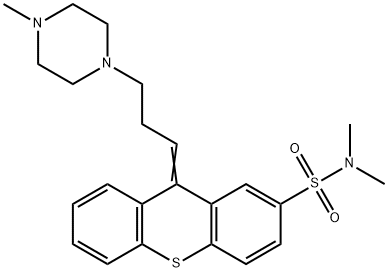| Company Name: |
Shanghai Synchem Pharma Co., ltd
|
| Tel: |
021-61984905-1 18016477331 |
| Email: |
synchempharma@aliyun.com |
| Products Intro: |
Product Name:CIS-THIOTHIXENE
CAS:5591-45-7
Purity:99% Package:g,kg,t
|
|
| | CIS-THIOTHIXENE Basic information |
| Product Name: | CIS-THIOTHIXENE | | Synonyms: | Orbinamon;p-4657-b;Thiothixine;Thioxanthene-2-sulfonamide, N,N-dimethyl-9-(3-(4-methyl-1-piperazinyl)propylidene)-;Tiotixene;N,N-dimethyl-9-[3-(4-methylpiperazin-1-yl)propylidene]thioxanthene-2-sulfonamide;N,N-dimethyl-9-[3-(4-methylpiperazin-1-yl)propylidene]-9H-thioxanthene-2-sulphonamide;THIOTHIXENE MEETS USP TESTING SPECIFICA | | CAS: | 5591-45-7 | | MF: | C23H29N3O2S2 | | MW: | 443.63 | | EINECS: | 227-001-0 | | Product Categories: | | | Mol File: | 5591-45-7.mol |  |
| | CIS-THIOTHIXENE Chemical Properties |
| density | 1.1399 (rough estimate) | | refractive index | 1.6560 (estimate) | | storage temp. | Store at -20°C | | solubility | DMF: 0.5 mg/ml; DMSO: 0.2 mg/ml | | form | A crystalline solid |
| | CIS-THIOTHIXENE Usage And Synthesis |
| Description | In 2002, the American Association of Poison Control Centers’
Toxic Exposure Surveillance System reported 5224 human
exposures to phenothiazines, thioxanthenes, and other neuroleptic
medications; 3691 were in adults and 808 in children.
Unintentional and intentional exposures accounted for 43.7
and 47.8%, respectively. There were 417 (8.0%) adverse drug
reactions reported. Thioxanthenes are chemical compounds in
which the oxygen atom in xanthene is replaced with a sulfur
atom. They are also related to phenothiazines. Several derivatives
are used as typical antipsychotics in the treatment of
schizophrenia and other psychoses. The thioxanthenes, as
a class, are closely related chemically to the phenothiazines. The
major structural difference is that the nitrogen at position 10 in
the phenothiazines is replaced by a carbon atom with a double
bond to the side chain, as shown in the chemical structure of
flupenthixol, which has a double-bonded carbon in the number
10 position. Clopenthixol is a typical antipsychotic drug of the
thioxanthenes class and a racemic mixture of cis and trans
isomers. Zuclopenthixol, the pure cis isomer, has been much
more widely used. Both drugs are equally effective as antipsychotics
and have similar adverse effect profiles, but clopenthixol
is half as active on a milligram-to-milligram basis and appears
to produce more sedation in comparison. | | Uses | Thioxanthenes are used as neuroleptic agents, antipsychotics,
and major tranquilizers in the treatment of psychosis,
including schizophrenia, senile psychosis, pathological jealousy,
and borderline personality disorder. Other uses include
the treatment of pain, postoperative neuralgia, sedation,
anxiety neurosis, childhood behavior problems, and depression.
The maximum therapeutic daily oral dose for chlorprothixene,
flupenthixol, and thiothixene is 600, 224, and 60 mg, respectively; the maximum intramuscular doses are
200 mg day-1, 100 mg weekly, and 30 mg day-1, respectively.
Some thioxanthenes and thioxanthenones have shown signs of
possible human therapeutic potential against tumors in mice
and in vitro assays, and some thioxanthenes have been shown
to have cytotoxic and antimicrobial activities.
Chlorprothixene is primarily indicated in conditions such as
agitation, mania, psychosis, schizophrenia, and can also be given
in adjunctive therapy as an alternative drug of choice for anxiety
and herpetic neuralgia. Flupenthixol (HCl and decanoate) is
primarily indicated in conditions such as depression, muscle
spasms of varied etiology, pain, personality disorder, postoperative
nausea and vomiting, psychosis, relief of discomfort in
mild urinary tract infections, and schizophrenia. Flupenthixol is
also seen to possess powerful antibacterial activity both in vitro
and in vivo in mouse experiments. It is bacteriostatic in vitro both
against gram-positive and gram-negative bacteria. Thiothixene is
used in the management of schizophrenia. It has not been
evaluated in the management of behavioral complications in
patients with mental retardation.
Zuclopenthixol is primarily indicated in conditions such
as dementia, to enhance permeation of subcutaneous or intramuscular injections, labyrinthine disorders, prolactinoma,
psychosis, schizophrenia, and second trimester abortion. It is
also used in the treatment of acute bipolar mania. | | Environmental Fate | Long-range transport: handling of thioxanthenes should
only be performed by personnel trained and familiar
with handling potent active pharmaceutical ingredients.
In case of handling, avoid inhalation and contact with
skin, eyes, and clothing, as these materials may be an
irritant. These substances are considered nonhazardous
for transport. | | Toxicity evaluation | Thioxanthenes work primarily by blocking postsynaptic
dopamine-mediated neurotransmission by binding to dopamine
(DA-1 and DA-2) receptors. In addition to significant
antidopaminergic action, the thioxanthenes also possess weak
anticholinergic and serotonergic blockade, moderate a-adrenergic
blockade, quinidine-like effects, and depress the release of
most hypothalamic and hypophyseal hormones. Thioxanthenes
may also inhibit presynaptic dopamine autoreceptors.
The concentration of prolactin is increased due to
blockade of prolactin inhibitory factor, which inhibits the
release of prolactin from the pituitary gland. Chlorprothixene
also inhibits the medullary chemoreceptor trigger zone to
produce an antiemetic effect; and is thought to cause an indirect
reduction of stimuli to the brain stem reticular system to
produce a sedative effect. |
| | CIS-THIOTHIXENE Preparation Products And Raw materials |
|